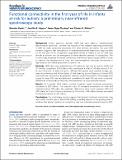| dc.contributor.author | Keehn, Brandon | en_US |
| dc.contributor.author | Wagner, Jennifer B. | en_US |
| dc.contributor.author | Tager-Flusberg, Helen | en_US |
| dc.contributor.author | Nelson, Charles A. | en_US |
| dc.date.accessioned | 2014-03-01T02:24:18Z | |
| dc.date.issued | 2013 | en_US |
| dc.identifier.citation | Keehn, Brandon, Jennifer B. Wagner, Helen Tager-Flusberg, and Charles A. Nelson. 2013. “Functional connectivity in the first year of life in infants at-risk for autism: a preliminary near-infrared spectroscopy study.” Frontiers in Human Neuroscience 7 (1): 444. doi:10.3389/fnhum.2013.00444. http://dx.doi.org/10.3389/fnhum.2013.00444. | en |
| dc.identifier.issn | 1662-5161 | en |
| dc.identifier.uri | http://nrs.harvard.edu/urn-3:HUL.InstRepos:11855769 | |
| dc.description.abstract | Background: Autism spectrum disorder (ASD) has been called a “developmental disconnection syndrome,” however the majority of the research examining connectivity in ASD has been conducted exclusively with older children and adults. Yet, prior ASD research suggests that perturbations in neurodevelopmental trajectories begin as early as the first year of life. Prospective longitudinal studies of infants at risk for ASD may provide a window into the emergence of these aberrant patterns of connectivity. The current study employed functional connectivity near-infrared spectroscopy (NIRS) in order to examine the development of intra- and inter-hemispheric functional connectivity in high- and low-risk infants across the first year of life. Methods: NIRS data were collected from 27 infants at high risk for autism (HRA) and 37 low-risk comparison (LRC) infants who contributed a total of 116 data sets at 3-, 6-, 9-, and 12-months. At each time point, HRA and LRC groups were matched on age, sex, head circumference, and Mullen Scales of Early Learning scores. Regions of interest (ROI) were selected from anterior and posterior locations of each hemisphere. The average time course for each ROI was calculated and correlations for each ROI pair were computed. Differences in functional connectivity were examined in a cross-sectional manner. Results: At 3-months, HRA infants showed increased overall functional connectivity compared to LRC infants. This was the result of increased connectivity for intra- and inter-hemispheric ROI pairs. No significant differences were found between HRA and LRC infants at 6- and 9-months. However, by 12-months, HRA infants showed decreased connectivity relative to LRC infants. Conclusions: Our preliminary results suggest that atypical functional connectivity may exist within the first year of life in HRA infants, providing support to the growing body of evidence that aberrant patterns of connectivity may be a potential endophenotype for ASD. | en |
| dc.language.iso | en_US | en |
| dc.publisher | Frontiers Media S.A. | en |
| dc.relation.isversionof | doi:10.3389/fnhum.2013.00444 | en |
| dc.relation.hasversion | http://www.ncbi.nlm.nih.gov/pmc/articles/PMC3734360/pdf/ | en |
| dash.license | LAA | en_US |
| dc.subject | autism | en |
| dc.subject | functional connectivity | en |
| dc.subject | near-infrared spectroscopy | en |
| dc.subject | endophenotype | en |
| dc.subject | infancy | en |
| dc.title | Functional connectivity in the first year of life in infants at-risk for autism: a preliminary near-infrared spectroscopy study | en |
| dc.type | Journal Article | en_US |
| dc.description.version | Version of Record | en |
| dc.relation.journal | Frontiers in Human Neuroscience | en |
| dash.depositing.author | Keehn, Brandon | en_US |
| dc.date.available | 2014-03-01T02:24:18Z | |
| dc.identifier.doi | 10.3389/fnhum.2013.00444 | * |
| dash.contributor.affiliated | Keehn, Brandon | |
| dash.contributor.affiliated | Nelson, Charles | |


